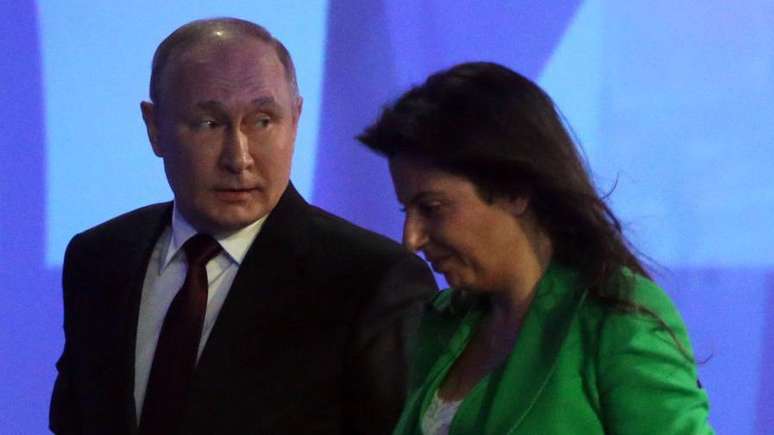The United States has accused Russia of interfering in the 2024 presidential election and announced sanctions against the country’s state media executives.
The White House’s recent revelations about Russia’s attempts to influence this year’s US presidential election come as no surprise to anyone who followed disinformation tactics during the last US election.
Throughout the 2020 campaign, the Kremlin used state-sponsored media outlets – such as the international television channel RT and the news website and radio station Sputnik – to spread a variety of content questioning the legitimacy of the US democratic process.
It was also discovered that the networks bot (robots) and troll (profiles, usually fake, that abuse, attack and provoke others on the Internet), sponsored by Russia, also promoted polarized disinformation and conspiracy theories on online networks.
This time, the United States seized a network of Russian-run Internet domains and announced sanctions against ten people, including Margarita Simonyan, editor-in-chief of RT (formerly Russia Today), for “activities aimed at undermining public trust in our institutions.”
The sanctions include freezing any U.S. property or assets and potentially restrictions on any U.S. citizen or company doing business with them.
The United States also charged two Moscow-based RT executives, Kostiantyn Kalashnikov and Elena Afanasyeva, under anti-money laundering law for paying American content creators to spread “pro-Russian propaganda and disinformation” on American soil.
U.S. Attorney General Merrick Garland said Russia was seeking its “preferred outcome” in the upcoming presidential election – and to undermine U.S. support for Ukraine in the war.
The practices denounced by the U.S. Department of Justice (DOJ) match what my co-authors and I identify in our new book Russia, Disinformation and the Liberal Order (“Russia, Disinformation and the Liberal Order”) as it has become standard practice in Russian attempts to influence international audiences.
Below are five of the key Russian intelligence manipulation tactics we’ve identified that can help you understand the latest election interference scandal.
1. Use local influencers
The Department of Justice accuses RT employees of paying a company based in the US state of Tennessee about $10 million (R$55.7 million) to produce social media content aligned with Russian interests, without disclosing that the funding came from the Russian state.
Several influencers with ties to the Tennessee company said they had editorial control over its content and denied knowledge of any ties to Russia. But that fits the patterns identified in our research.
First, RT has long worked in the right-wing populist media space – and often mimics the style and practices of US right-wing populist media. It frequently links to its articles on its website, promotes right-wing media personalities and organizes their programs, as well as featuring them on its own platforms.
On this basis, RT has often offered a platform, funding, and carte blanche to media personalities from targeted states whose authentic beliefs serve Russia’s interests. After all, research confirms that people are more likely to believe claims they hear repeatedly, regardless of whether those claims are true or not.
2. Fake news
As part of this case, the United States seized a network of Internet domains allegedly used to spread false information aimed at specific subgroups of the U.S. population. Disguised as local sites, their content tends to explore specific social concerns and controversies that resonate with certain target groups, as well as amplify key Russian talking points.
We’ve seen this before, when the Kremlin-backed Internet Research Agency created a fake left-wing news site and tricked unsuspecting freelancers into contributing content to Russian information operations. RT’s past activities show that the broadcaster has no qualms about deliberately disguising its connections to other media operations and groups.
We know from our research that not only do these sites often cross-reference each other, but they also often cross-reference other, antithematic sites with the same name. mainstream to increase your credibility with certain online demographics.
3. Add fuel to the fire
Another common tactic to maintain the credibility of content is to connect it to fears and concerns that are already prominent in any society. For example, Russia did not bring the culture war to the United States, but it has skillfully exploited American society’s concerns about the issue. Russian media operations have exposed this fact without engaging them in any meaningful way.
Similarly, when Russian websites masquerade as local sources, they prioritize topics that are familiar to their target audience. Typically, however, controversial topics are embellished with a patchwork of factual and fictional information. Audiences find it difficult to separate them, and their initial assumptions mean they are often unmotivated to try.

4. Reverse the situation
Moscow has repeatedly denied any involvement in influence campaigns, as it did in 2018 when the UK accused the Russian state of a series of novichok poisonings in the city of Salisbury. At the time, Russian politicians and media promoted a complex web of conspiracy theories that mirrored accusations against the UK and US security services.
This time too we have witnessed the Russian authorities trying to “turn the tables” by turning the tables. Moscow’s ambassador to Washington, Anatoly Antonov, dismissed the US accusations as a product of “Russophobia” – the same term used by the Russian embassy after the Salisbury poisonings.
And Russian Foreign Ministry spokeswoman Maria Zakharova repeated her favorite argument of recent years, accusing the United States of becoming a “totalitarian neoliberal dictatorship.” This may sound ridiculous coming from a representative of a state that has criminalized criticism of its invasion of Ukraine. However, outright lies and good-natured denials often go hand in hand in Russia’s information operations.
5. Humor
The Russian state routinely uses humor strategically, and RT has emerged as something of a pioneer in using humor to legitimize Russia’s actions or defuse criticism.
But the network doesn’t just use humor to report on international politics. Its signature approach is to consciously include itself as part of the joke. Several RT advertising campaigns have used foreign criticism as a theme.
The same spirit was evident in Simonyan’s sarcastic response to the latest accusations. In comments posted on Telegram and wittily reproduced by RT, the editor-in-chief dismissed the accusations as American scaremongering “about the almighty RT.” His words are a perfect example of how RT revels in its status as a “populist pariah.”
Russia continues to refine the way it seeks to influence agendas beyond its borders, and there is no sign that will stop any time soon.
*Precious Chatterje-Doody is Professor of Politics and International Studies at the Open University in the UK.
This article was originally published on the academic news website The conversation and republished here under a Creative Commons license. Read the original version here (in English).
Source: Terra
Rose James is a Gossipify movie and series reviewer known for her in-depth analysis and unique perspective on the latest releases. With a background in film studies, she provides engaging and informative reviews, and keeps readers up to date with industry trends and emerging talents.







